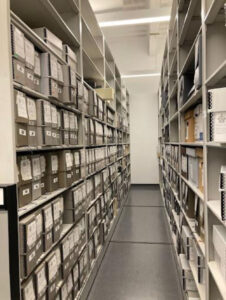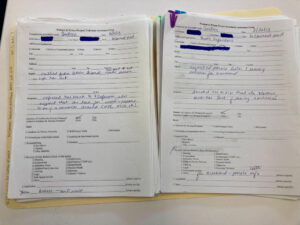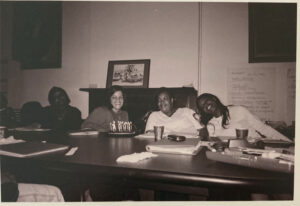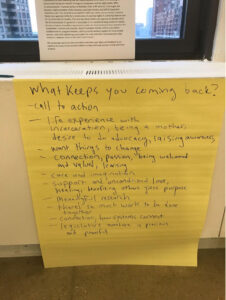Toward an Abolitionist Archival Practice
It was a fall day in September 2021. I was in Barnard College’s library sort of doing homework in my favorite green chair, when my phone buzzed with an email that piqued my interest. The email said that archivists at Barnard had just returned from a trip to New Jersey with a car full of boxes from a recently sunsetted organization called the Coalition for Women Prisoners (CWP). They had a project for me.
As I came to learn, the CWP was an organizing formation founded in 1994 by activists who believed it was crucial to organize against the particular ways women experience the violence of policing and prisons. Originally, the CWP was coordinated by the Women in Prison Project, a branch of a larger prison reform nonprofit called the Correctional Association of New York (CANY). Like its parent organization, the CWP’s original members were lawyers, non-profit professionals, and government workers, but over the trajectory of the Coalition’s lifetime, the CWP made decisions that shifted participation and leadership to incarcerated and formerly incarcerated women. To facilitate this change, CWP leaders developed a program called ReConnect, which brought formerly incarcerated organizers like Stacey Thompson, Anisah Sabur, Lorraine Patterson, and LadyKathryn Williams Julien to the center of the CWP’s work.
ReConnect provided material support to formerly incarcerated participants transitioning out of prison, jail, and alternative-to-incarceration programs. At the same time that it provided practical assistance, it also taught political organizing skills so that its members could connect direct service and advocacy and ultimately lead the work. Following the leadership transition, the CWP campaigned for legislative change in New York. They won fights to increase legal protections for criminalized survivors of domestic violence, banned the shackling of incarcerated pregnant people, reduced the state’s ability to separate incarcerated parents from their children through the family policing system, and limited the use of solitary confinement in New York state prisons.
But in 2019, the Correctional Association terminated its women’s advocacy program and transferred the Coalition’s assets to a different organization, STEPS at Rising Ground. This left the CWP with a series of financial and logistical challenges. Faced with these material difficulties, and reflecting on its role in a growing and vibrant landscape of organizing against women’s incarceration, members decided to sunset the coalition in July 2021. But CWP members knew that their impact could persist long after the formal sunset, so they decided to compile their records and find an archival home so that students, scholars, and organizers could continue to learn from their organizing and theorizing. They agreed that Barnard’s Archives, already filled with materials from anti-carceral feminist movements, would be the right home. Organizational records were packed into boxes and uploaded onto flash drives, doors were closed, and by September the boxes were stacked in the archives at Barnard College, waiting to be processed.
As someone involved in organizing against policing and prisons, I felt eager to take on the task of preserving a bit of this history. I did some research to equip myself with preliminary information about the CWP and, with the archivists’ incredibly detailed processing manual, I arrived at the reading room greeted by large boxes spilling with frayed envelopes, overflowing binders, and the colorful edges of photographs, artwork, and banners, not to mention piles of disks and flash drives loaded with photos, films, and other documents. In the following weeks, I immersed myself in the worlds of the CWP, leafing through organizational records, personal narratives, photographs, artwork, films, and political education materials from twenty-seven years of organizational life.
My unabashed eagerness melded with a cautious ambivalence as I confronted the complexities and queries of institutional memory work. Going into the project, I thought archival processing would be mostly tedious, mindless work, stuffing things into folders, making some labels, putting data into spreadsheets. But as I moved through the process, my mind swirled with questions: What language would I use to describe the CWP’s work and political orientation? How would I arrange materials: By donor, by content, by chronology, by medium, by something else entirely? How would I handle the personal information of people whose lives were encapsulated in the archive? What does it mean to archive materials from formerly incarcerated people when the archive itself can be a carceral space?
I’m embarrassed to admit how much sleep I lost perseverating over questions like these. I was determined that if I thought hard enough or collected enough people’s opinions I would eventually land on the singular, definitive, right, correct, most ethical answers to the dilemmas presented by the archive. But as abolitionist thinkers and practitioners teach us, knowing the answers is not a prerequisite to engaging in projects of radical world-building: We cultivate answers through practice, experimentation, and mistakes. Perhaps I say this as a warning that this writing won’t offer any neatly packaged answers to the fraught questions of archives, carcerality, and historical memory. As much as I wanted it, I’ll resist closure and certainty and take instead the invitation into more collective scheming about abolitionist archival praxis.
~
One of the first items I encountered from the collection was the deed of gift, the contract agreement between the CWP donors and the Barnard College Archives and Special Collections. It cemented the transfer of materials and the terms of use. The document was full of legal jargon about copyright and FERPA and taxes, the kind of thing that normally makes me drowsy, but one particular sentence yelled to me from the page: The Materials shall become the permanent property of the Donee and will be maintained by the Barnard Archives.
Property. As in the foundational unit of racial capitalism. As in the logic that justifies settler colonial theft of Indigenous lands. As in the logic that articulated Black people as commodities through transatlantic slavery. As in the entity that necessitates policing, surveillance, and incarceration. What would it mean for the CWP materials to be drawn through the grammar of private property, subsumed into a relation of ownership?

The Barnard Archives reading room is a sun-filled space with huge glass windows looking out onto 116th and Broadway. This is where I sat as I read the deed of gift. Whenever I looked up to take a break from reading documents, I looked out to see a landscape shaped by precisely this dispossession, extraction, and violence: Columbia University, one of the largest private landowners in New York City, a glaring reminder of the violence of private property.
I looked down and read again: These materials should become permanent property of the donee.
Scholars like Saidiya Hartman, Rod Ferguson, and Jarret Drake teach us that the archive has historically functioned as a site of containment, disciplining our collective understanding of history and the present toward the needs and desires of the racial capitalist state. I thought about how my interactions with the material history of the CWP, full of strategic movement reflection, organizing wisdom, and records of powerful collective action against oppression were being disciplined by the institution where I worked. How might their location here, and my curation, confine the liberatory potential of this history? As the weeks went on and I stuffed the CWP materials into uniform gray boxes, I kept wondering: What was I doing boxing up lives inside this archive? What would happen to them here?
Grappling with the potential harms of the archive also generated questions about possibilities for an anti-carceral archive. Perhaps we can think about the life-affirming stories, theory, and art that fill the CWP archival collection as a direct challenge to the dominance of carceral archives that attempt to reduce the complexity of lives into statistics and mug shots. When the CWP donated its materials to Barnard, they made it clear that they did not see the neat file folders or the glassy building in which they would live as a final resting place. They wanted their history to take on a new life for folks involved in ongoing feminist struggles against carcerality. So that is what we are trying to do with this collection, to help cycle its wisdom back into movements for justice and liberation.
~
The first time I spoke with Andrea Williams, a former CWP member whose words and work are scattered throughout the collection, I blurted, “This might sound creepy, but I feel like I already know you.”
I did not really know her. I knew the assemblage of her life made legible through the fragments of the archive. But, in a clumsy confession, perhaps I was beginning to articulate an understanding of the archive as a site of relationship-building. In this relational space, I could rehearse anti-carceral modes of care for historical memory.
Conventional methodologies of history and archival practice instruct differently. They compel us to relate to archival materials and the lives encapsulated within them as objects of study. These are items to collect, store, analyze, trade, and sell. An anti-carceral practice asks, How might we disrupt the power of the researcher over the studied? Reading their documents, I tried to listen to CWP members as comrades, co-conspirators, and teachers. I wanted to build relationships based on mutual care, not to extract from people’s lives for academic prestige or material gain. And as it turned out, the CWP materials had a lot to teach me about the central value of relationships in social justice movements.
As I made my way through the boxes, there remained an untouched stack of thick manilla envelopes, ten of them, each one accounting for a year of the CWP’s existence. Inside the envelopes were the ReConnect technical assistance forms, which the staff used to keep records of their correspondence with program participants and collaborators. Each time I came to work, they glared at me, and I avoided them in return. They sat neatly on that corner desk for longer than I’d care to admit.

Beyond being daunted by their sheer volume, initially I dismissed them as boring bureaucratic drudgery, far less enticing than materials from big protests and direct actions, official policy reports, or notes from high stakes meetings. At one point, the other archivists and I even discussed leaving them out of the collection altogether. Perhaps they did not have enough research value to justify the time it would take to process them and protect the personal information within them, we said.
But, as luck would have it, I was in a class with Professor Sarah Haley reading Abolition Feminism Now. The book makes the point that, just as much as we pay attention to campaign wins and external achievements, we must also pay attention to what kinds of internal life-worlds social movements create. Believing this to be true, I had no choice but to turn back and reevaluate my conclusions about those technical assistance forms.
In the subsequent weeks, I spent hours and hours reading those papers. ReConnect participants and mentors wrote to each other to ask for support, resources, or advice for themselves and their loved ones, to share ideas for new political organizing and mutual aid projects, or just to check in and send updates on their lives. In the space of these everyday interactions, CWP members showed up to meet each other’s needs, held emotional space, built infrastructure for community, and cultivated a deep sense of mutual care. These documents were far from boring. They radiated with life, care, and trust.
I realized that my assessment of these documents as unimportant was rooted in my own internalized devaluation of the gendered labor of care. Social movements are, at their core, networks of complex, interlocking relationships. So to truly understand how movements build power, I must value the ways that organizing formations cultivate, sustain, and nourish relationships.

Through these technical assistance forms and other documents spanning the decades, CWP members consistently identified the political power built through anti-carceral relationality as the organization’s major strength. The practical, material application of anti-carceral relationally meant that people were not disposable, kinship and community were protected, and people were valued in their whole personhood. Elsewhere in the collection, there is a photo of a large piece of yellow butcher paper—a familiar medium for activists—documenting notes from a strategic planning convening in 2017. At the top of the paper is the question, What keeps you coming back? I imagine the meeting space buzzing with voices brainstorming, reflecting, scheming, and a scribe hurriedly writing the words:

life experience with incarceration
connection
passion
being welcomed and valued
care and imagination
support and unconditional love
there’s so much work to be done together
A mainstream historical account might list the CWP’s accomplishments as their numerous legislative wins, but on this one piece of butcher paper, CWP members elucidated how the coalition’s value did not begin or end with the laws they helped pass or campaigns they won. Its strength lay in the way they imagined, practiced, and materialized a vision for a liberated world within the space of their relationships. The CWP practice demonstrating the power of relationships extends more broadly to our engagement with the archive. In the space of the archival encounter is a chance to practice a radically different way of relating with the past and the people who made it.